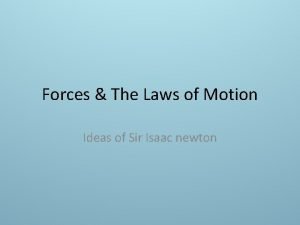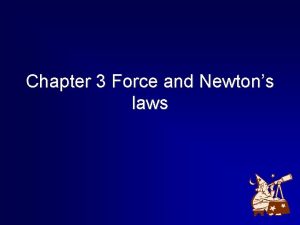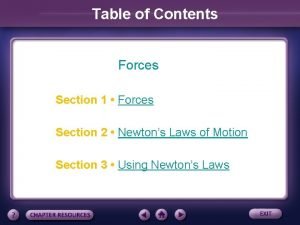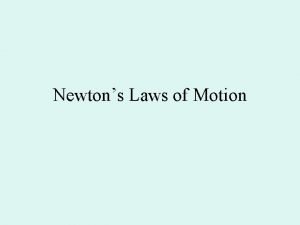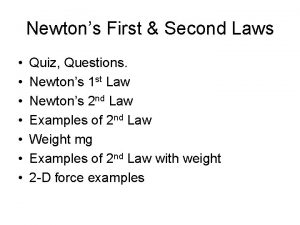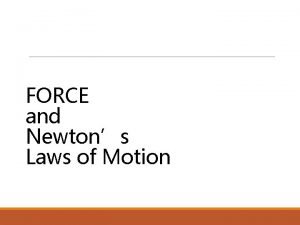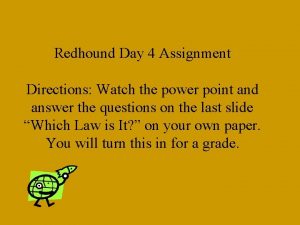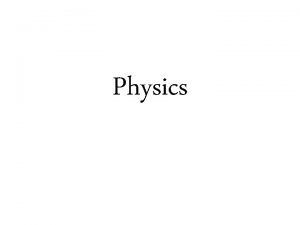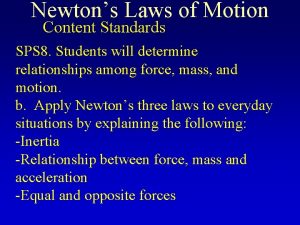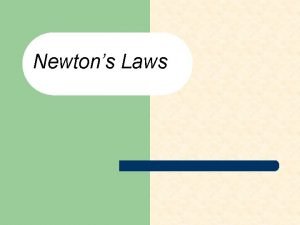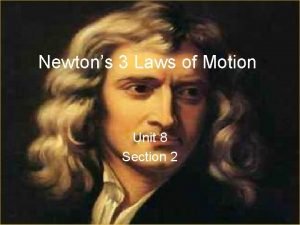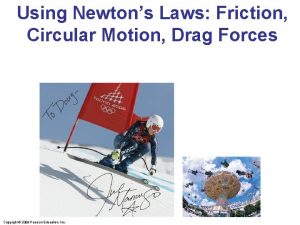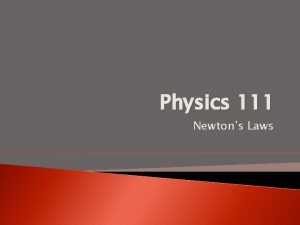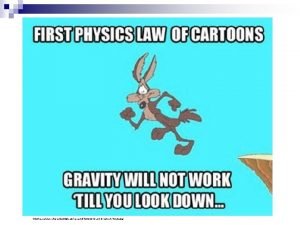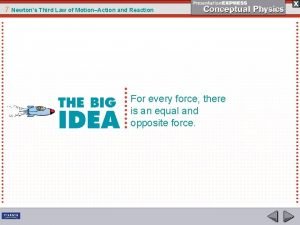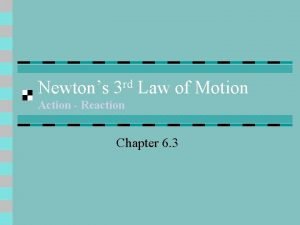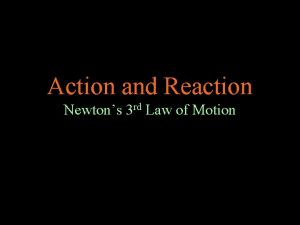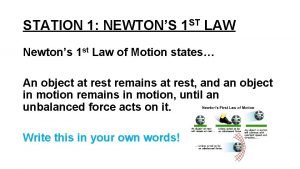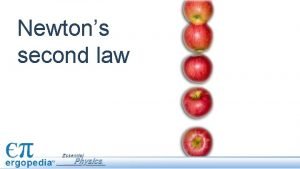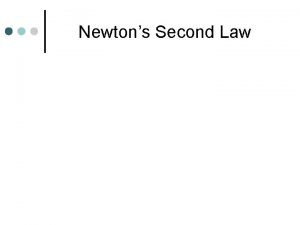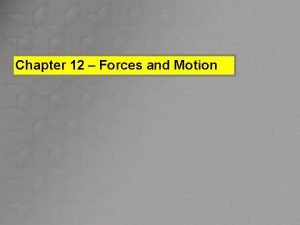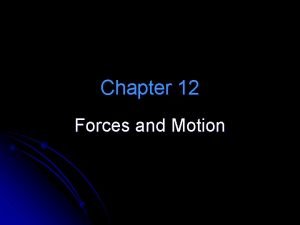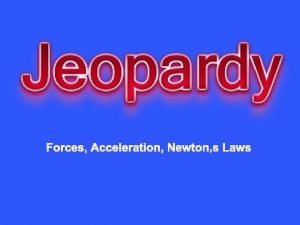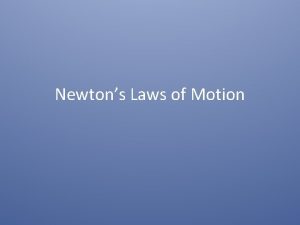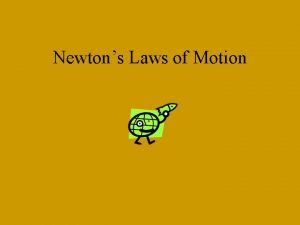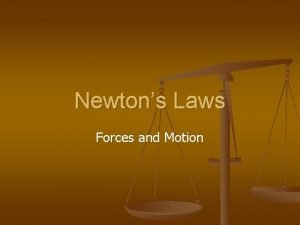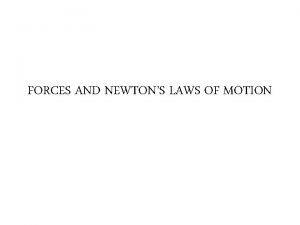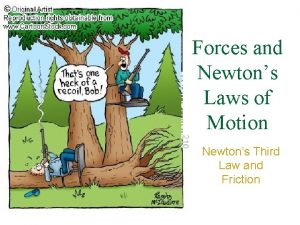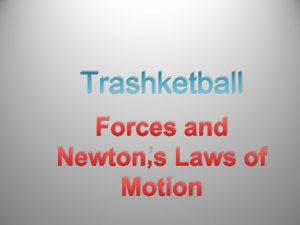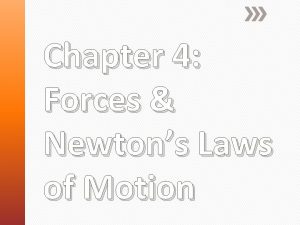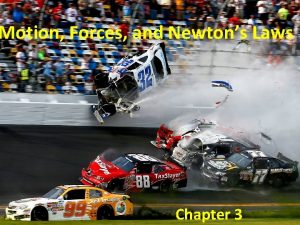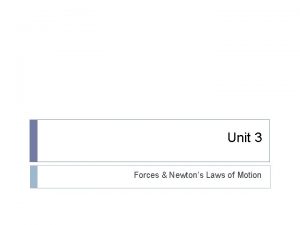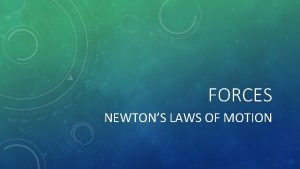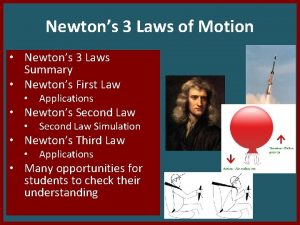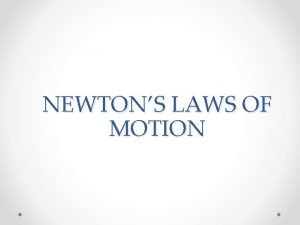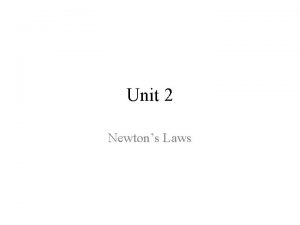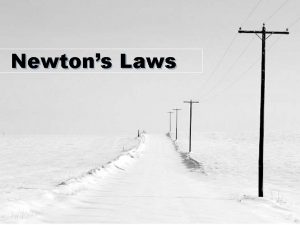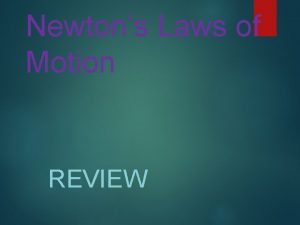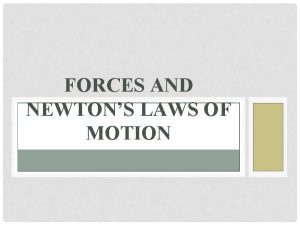Chapter 4 Forces and Newtons Laws of Motion











































- Slides: 43

Chapter 4: Forces and Newton’s Laws of Motion • • • Forces Newton’s Three Laws of Motion The Gravitational Force Contact Forces (normal, friction, tension) Application of Newton’s Second Law Apparent Weight Air Resistance Fundamental Forces CQ: 16, 18. P: 3, 5, 21, 37, 41, 63, 73, 87, 97, 147. 1

Force Concept Contact Forces Ex: car on road, ball bounce Non-Contact Ex: magnetism, gravity / 2

units • • Force units (SI): newton, N 1 N ≈ ¼ lb. 1 N = (1 kg)(1 m/s/s) N/kg = m/s/s 3

Inertia • is ‘resistance’ to change in velocity • Measurement: Mass • SI Unit: Kilogram (Kg) • / 4

Universal Law of Gravity • all matter is weakly attracted • attraction is inverse-square with distance • G = 6. 67 x 10 -11 N·m 2/kg 2 • Example: Two 100 kg persons stand 1. 0 m apart 5

g vs G • G is universal • g ~ Mass and Radius • / 6

Contact Forces • Surfaces in contact are often under compression: each surface pushes against the other. The outward push of each object is called the Normal Force. • If the objects move (even slightly) parallel to their surface the resistance force experienced is called the frictional force. 7

Normal forces are? 1. Always vertically upward. 2. Always vertically downward. 3. Can point in any direction. 8

Tension & Compression • Compressed objects push outward away from their center (aka Normal Force). • Stretched objects pull toward their center. This is called the Tension Force. 9

Force Label Notation • • • F = general force FN = normal force f = frictional force w = mg = Fg = weight T = tension force / 10

Net Force = change of motion vector sum of all forces acting on an object 11

Example: Net Force = 0, Ball rolls along a smooth level surface constant velocity Force Diagram table force Fnet = 0 a=0 weight force 12

Example: Net-force on 0. 5 kg • Net-force = 4 N: Acceleration = 4 N/0. 5 kg = 8 m/s/s • 5 N, Right; 3 N Left; Net-force = 2 N Acceleration = 2 N/0. 5 kg = 4 m/s/s • Falling; Net-force = mg Acceleration = mg/m = g = 9. 8 m/s/s • / 13

Newton’s Laws of Motion 1. An object maintains constant velocity when the Net -Force on it is zero. 2. An object’s acceleration equals the Net-Force on it divided by its mass. 3. Forces always occur in pairs equal in size and opposite in direction. 14

Force Diagrams • Object is drawn as a “point” • Each force is drawn as a “pulling” vector • Each force is labeled • Relevant Angles are shown • x, y axes are written offset from diagram • Only forces which act ON the object are shown 15

Example of a Force Diagram for a Sled net force equals the mass times its acceleration. 16

g’s • one “g” of acceleration = 9. 8 m/s/s • “two g’s” = 19. 6 m/s/s, etc. • Example: What is the net force on a 2100 kg SUV that is accelerating at 0. 75 g? • Net-force = ma = m(0. 75 g) = 0. 75 mg = ¾ weight of car. • / 17

Block on Frictionless Incline • a = wx/m =mgsinq/m • = gsinq. • F n = w y. 18

Newton’s 3 rd Law of Motion • equal-sized oppositely-directed forces • Independent of mass • Pair-notation x x 19

Newton’s 3 rd Law Pair Notation • use “x” marks on forces that are 3 rd Law pairs. • Use “xx” for a different interaction, etc. 20

Force Diagram each object. Which has greater acceleration when released? Spring Force x Acceleration = F/m Spring Force x Acceleration = F/(2 m) 21

Friction • • • Static Friction “sticking force” Kinetic Friction “sliding force” Coefficients: 0 = min, 1 ~ max e. g. teflon around 0. 05 Rubber on concrete around 1. 0 22

Using Coefficients of Friction • Ex. 10 kg block. FN = weight = mg = 98 N. Static coef. = 0. 50; Kinetic coef. = 0. 30. 23

Applications 24

A 3 kg object sits on a frictionless table. Two horizontal forces act, one is 2 N in the y-direction, the other 4 N in the xdirection. A top-view diagram will be shown. What is the magnitude of the net-force acting? 2 Fnet 2 4 25

What direction does the 3 kg mass accelerate? parallel to Fnet by Newton’s 2 nd Law. We are in Quadrant I since x and y are both + 2 Fnet 2 4 26

The magnitude of the acceleration is: 27

Two 1 kg Blocks; a = 1 m/s/s F • Fnet = F = (2 m)a = (2 kg)(1 m/s/s) = 2 N • Fnet = T = ma = (1 kg)(1 m/s/s) = 1 N • / 28

Two 1 kg Blocks; F = 10 N F • a = F/(2 m) = 10 N/2 kg = 5 m/s/s • T = ma = (1 kg)(5 m/s/s) = 5 N • / 29

4 Summary • Fnet = ma (Fnet = 0, v = constant) • forces always occur in pairs of equal size and opposite direction • various force types (& symbols) • equilibrium problems (a = 0) • dynamic problems (a ≠ 0) 30

30 60 90 30 Mg, 300 deg. 31

Inclined Plane Forces • Fxnet = FNcos 90 + mgcos 300 = (0. 02)(a) • = 0 + (0. 02)(9. 8)(0. 5) = (0. 02)a • accel = 4. 9 m/s/s • Fynet = FNsin 90 + mgsin 300 = (0. 02)(0) • FN + (0. 02)(9. 8)(-. 866) = 0 • FN = 0. 17 N 32

Ex: Newton’s 2 nd Law Fnet acceleration 33

Coefficients of Friction Ex: Block&Load = 580 grams If it takes 2. 4 N to get it moving and 2. 0 N to keep it moving 34

Example: 1. 3 kg box on level frictionless surface. F=86 N acts 60° below horizontal. 35

1. (cont) 36

Q 1. What are ax and FN if angle is 30? 37

Interaction Notation • Since all forces are ‘pairs’, label as interactions, e. g. 1 on 2, 2 on 1, etc. • F 12 = “force of object 1 on object 2” • F 21 = “force of object 2 on object 1” • F 34 = “force of object 3 on object 4” • Etc. 38

Interaction Notation Symbols • • F 12 – general force, 1 on 2 N 12 – normal contact force, 1 on 2 f 12 – frictional force, 1 on 2 W 12 – gravitational force, 1 on 2 T 12 – tension force, 1 on 2 m 12 – magnetic force, 1 on 2 e 12 – electrical force, 1 on 2 39

Gravitational Force • All masses attract via gravitational force • Attraction is weak for two small objects • Ex: Attraction between two bowling balls is so small it is hard to measure. • Force is proportional to mass product • Force is inversely proportional to the square of the distance between objects 40

Example: Net Force = 0. Block on a surface inclined 30° from horizontal. Applied force F acts 40° below horizontal. Net Force = 0 velocity = constant 41

Diagrams with Interaction Notation • If f 21 exists, then f 12 also exists, and is opposite in direction to f 21. • f 21 and f 12 act on different objects. 42

Example: A 10 kg box is being pushed along a horizontal surface by a force of 15 N. A frictional force of 5 N acts against the motion. We will want to (a) Calculate the net-force acting and (b) calculate the acceleration of the box. The net-horizontal force determines its x-acceleration The y-acceleration is known to be zero because it remains in horizontal motion, thus The net-force is 10 N horizontal (0 vertical) The x-acceleration is: 43
 Newtons laws od motion
Newtons laws od motion Newtons first lw
Newtons first lw Newtons 3 laws
Newtons 3 laws 3 newton's law
3 newton's law Forces and the laws of motion problem b
Forces and the laws of motion problem b Newton's law
Newton's law 6 67 x 10^-11
6 67 x 10^-11 Newtons 3 rd law example
Newtons 3 rd law example Newtons laws of gravity
Newtons laws of gravity Section 3 using newtons law
Section 3 using newtons law Section 3 using newtons laws
Section 3 using newtons laws Abcd8n
Abcd8n What are newtons 3 laws
What are newtons 3 laws Newton's first and second law quiz
Newton's first and second law quiz Newton's 3rd law example
Newton's 3rd law example Newton's three laws
Newton's three laws What is the newton's law
What is the newton's law Newton laws
Newton laws Newton's laws
Newton's laws Second law of motion examples
Second law of motion examples 3 laws of newton
3 laws of newton Law of inertia
Law of inertia Law of friction
Law of friction Newtons laws
Newtons laws Newtons 3 rd law of motion
Newtons 3 rd law of motion Newtons 3 rd law of motion
Newtons 3 rd law of motion Third
Third Rd law
Rd law Newton's first law meme
Newton's first law meme Newtons third law
Newtons third law Newton's third law
Newton's third law Newtons 3 rd law of motion
Newtons 3 rd law of motion Newtons 3 rd law of motion
Newtons 3 rd law of motion Newtons 1st law.
Newtons 1st law. Application of newton's second law
Application of newton's second law Newton's 2nd law example
Newton's 2nd law example Newtons law of motion
Newtons law of motion Chapter 12 forces and motion
Chapter 12 forces and motion Chapter 12 forces and motion
Chapter 12 forces and motion Useless laws weaken the necessary laws
Useless laws weaken the necessary laws Resultant of two parallel vectors
Resultant of two parallel vectors What is contact force
What is contact force Balanced forces and unbalanced forces venn diagram
Balanced forces and unbalanced forces venn diagram What is constructive force
What is constructive force




